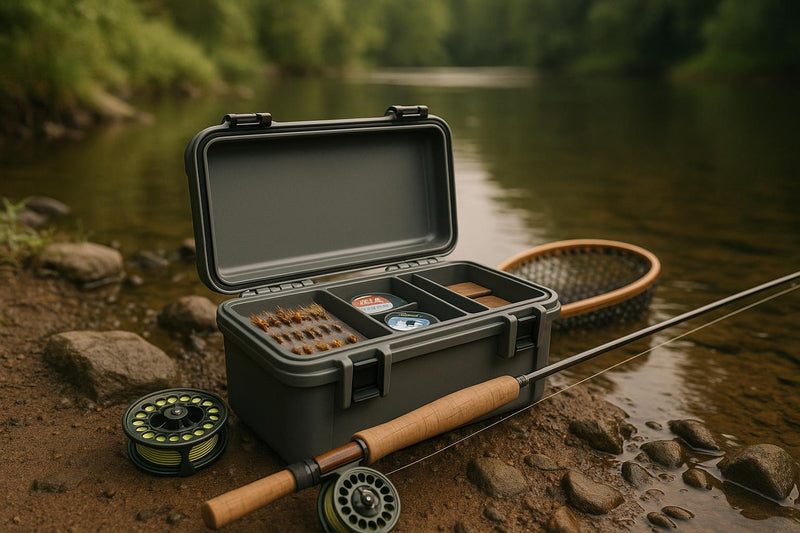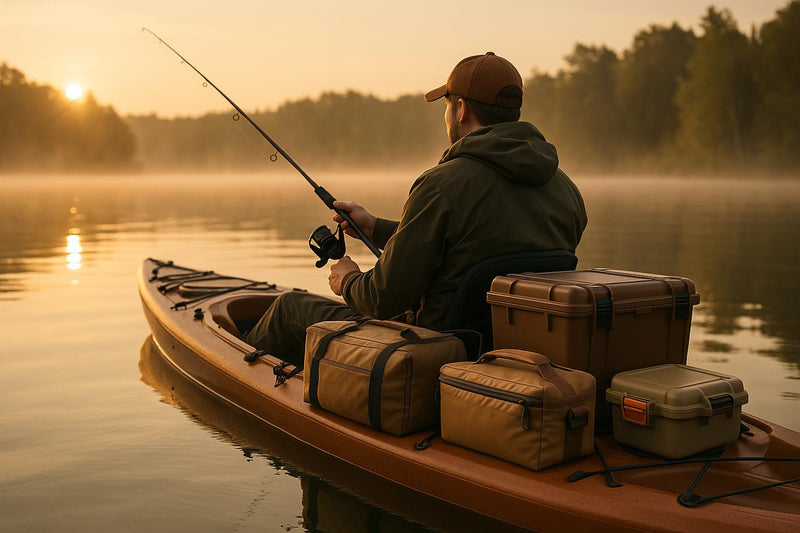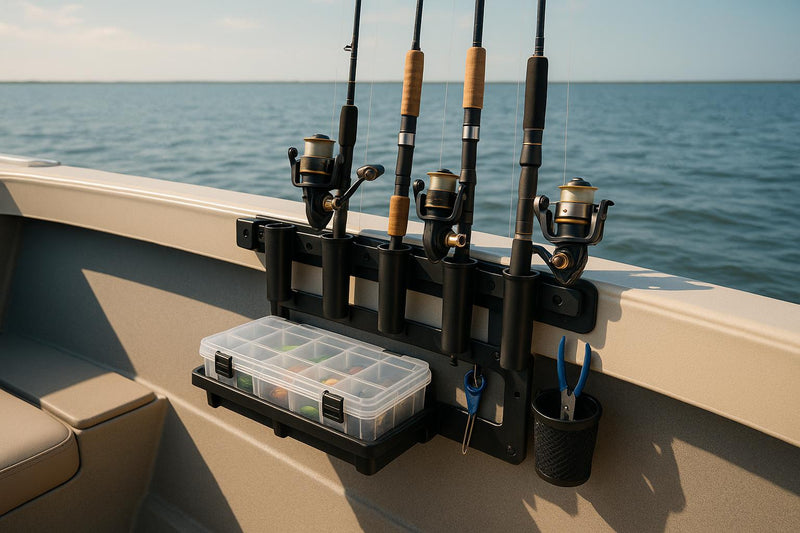Waterproof fishing bags are essential for anglers who want to protect their gear from water damage. Unlike regular tackle bags, these are specifically designed to keep your equipment safe and dry in wet conditions. Here's what you need to know:
- Key Features: Roll-top closures, waterproof zippers, sealed seams, and durable bases ensure water stays out.
- Materials: PVC tarpaulin, TPU-coated nylon, and trilaminate fabrics offer strong waterproof protection.
- Benefits: Keep electronics, bait, and clothing dry while resisting wear and tear.
- Options: Choose from dry bags, waterproof tackle bags, or fishing backpacks depending on your needs.
- Care Tips: Rinse with fresh water, clean zippers, and store in a cool, dry place to maintain performance.
Pair your waterproof bag with quick-dry gear like fishing shorts for maximum comfort and efficiency on the water.
Key Materials and Construction Features
The performance of a fishing bag largely depends on the materials used and the construction methods employed. Understanding these elements is key to selecting gear that can withstand the demands of challenging, water-heavy environments.
Here's a closer look at the fabrics and techniques that ensure reliable waterproof protection.
Waterproof vs. Water-Resistant Fabrics
People often mix up "waterproof" and "water-resistant", but they provide different levels of protection. Waterproof fabrics create a complete barrier that prevents water from penetrating, even during full submersion or prolonged exposure. On the other hand, water-resistant fabrics can handle light rain or splashes but will eventually let water seep through.
To measure waterproofness, the industry uses the hydrostatic head test. A fabric must resist more than 1,000 mm (about 39 inches) of water pressure to qualify as waterproof. For serious anglers, waterproof materials are a must since fishing often involves constant splashes and the potential for submersion. Popular waterproof materials include PVC tarpaulin, TPU (Thermoplastic Polyurethane), and treated nylon or polyester. These materials are often laminated or coated with substances like polyurethane to create a dependable water barrier.
Water-resistant fabrics, while lighter and more breathable, are typically made from tightly woven nylon or polyester treated with a Durable Water-Repellent (DWR) finish. However, even the best water-resistant fabric is only as good as its seams.
| Material Type | Protection Level | Best Use Case | Key Limitations |
|---|---|---|---|
| Waterproof Fabrics | Total water barrier; no penetration even when submerged | Heavy-duty fishing, marine use | Less breathable, bulkier, higher cost |
| Water-Resistant Fabrics | Shields against light rain and splashes; not submersion-proof | Light fishing, casual outings | Ineffective for heavy exposure or submersion |
Both fabric types play a role in performance, but only waterproof materials can handle the toughest fishing conditions.
Construction Techniques for Maximum Durability
The choice of material is only half the equation - construction techniques are just as critical for ensuring waterproof performance and durability. High-quality waterproof bags rely on advanced methods like RF (Radio Frequency) welding, heat-sealing, and multi-layer lamination to create strong, seamless barriers.
PVC tarpaulin is a standout material for durability. It resists water, punctures, abrasions, UV rays, and chemicals, making it ideal for saltwater fishing. High-frequency welding eliminates the weak points created by traditional stitching, ensuring watertight seals that last over time. Plus, PVC tarpaulin is easy to clean after messy fishing trips.
TPU coatings offer a balance of tensile strength and flexibility. When applied to high-denier nylon, TPU creates a lightweight yet durable waterproof barrier. However, TPU can degrade with extended UV exposure and is often more expensive than PVC.
High-denier nylon, particularly in Ripstop or Ballistic forms, is another top choice for premium waterproof bags. Its tear-resistant properties pair well with waterproof coatings, and the denier rating (indicating thread thickness) helps gauge its strength - higher numbers mean tougher fabric.
For the ultimate in waterproof protection, trilaminate fabrics combine three layers: an outer protective layer, a waterproof membrane, and an inner liner. This multi-layered approach not only blocks water but also maintains the bag's structural integrity.
Seam construction is equally important. Traditional stitching can create tiny holes that allow leaks, so premium bags often feature welded seams that fuse materials together. When stitching is unavoidable, waterproof tape is used to reinforce weak points and prevent seepage.
Whether it’s the high-tech materials or the meticulous construction, these features ensure your gear can handle the demands of fishing season after season. Just like our Fishing Shorts and Mens Fishing Shorts are built with quality fabrics, these construction techniques make all the difference in creating gear you can rely on when it matters most.
Top Waterproof Fishing Bags for Anglers
Check out some of the best waterproof bags designed to handle a variety of fishing conditions. These options combine durability with features that meet the needs of serious anglers.
Comparison of Leading Waterproof Fishing Bags
When it comes to waterproof fishing bags, the market offers a range of choices suited for different fishing styles and environments. From simple dry bags to tackle-specific models, there’s something for every angler.
Dry bags are a classic choice, offering a no-frills design that keeps your gear protected. Roll-top closures are especially popular because they create multiple layers of protection with just a few folds. These bags come in various sizes, from compact options for essentials to larger ones perfect for extended fishing trips.
For those needing more organization, waterproof tackle bags are a game-changer. These bags come with multiple compartments and clear pockets, making it easy to separate and access your gear. Many even include removable trays, offering quick access without compromising the waterproof seal.
If you’re an angler on the move, waterproof fishing backpacks might be your best bet. They combine the functionality of a traditional backpack with excellent water resistance. Features like padded shoulder straps, external rod attachment points, and easy-access pockets make them a practical choice for long fishing outings.
For many anglers, a medium-sized waterproof tackle bag with adjustable compartments hits the sweet spot between storage capacity and portability. Additionally, choosing a bag with a verified submersion rating can provide extra peace of mind in tough conditions.
To get the most out of your fishing setup, consider pairing your waterproof bag with gear designed to enhance both comfort and performance.
How Reel Comfort Fishing Shorts Work with Your Gear
Pairing your waterproof bag with the right apparel can make a big difference in your fishing experience. For instance, Reel Comfort Fishing Shorts are designed to complement waterproof bags while keeping you comfortable and agile.
These shorts feature removable thigh pads, which offer much-needed support when carrying a heavy waterproof backpack or a loaded tackle bag. This feature helps distribute weight evenly, reducing pressure points during long hours on the water.
The quick-dry fabric in these shorts is another standout feature. While your bag protects your gear from water, you might still face splashes, rain, or wading through shallow waters. The quick-dry technology ensures you stay comfortable even in damp conditions.
Functional storage pockets are another practical addition. They let you keep essentials like pliers, small tackle, or your phone within easy reach, while your waterproof bag safely stores backup gear and electronics.
With water-resistant fabric and an ergonomic design, these shorts provide a full range of motion and comfort, even when you’re carrying extra gear all day. Whether you're fishing from a boat or trekking to a remote spot, these shorts are built to keep up with you.
For a deeper dive into why purpose-built gear matters, check out comparisons like padded fishing shorts vs regular shorts and fishing shorts vs casual cargo shorts. Pairing a dependable waterproof bag with well-designed Fishing Shorts ensures you’re ready for anything on your next fishing trip.
Maintenance and Care Tips for Waterproof Fishing Bags
Keeping your waterproof fishing bag in good condition ensures it stays dependable for years of fishing adventures. Routine care not only extends its lifespan but also keeps your gear safe and ready when you need it most.
Cleaning and Maintenance Best Practices
After every fishing trip - especially if you've been in saltwater - give your bag a thorough rinse to remove salt crystals that can harm coatings and zippers. Use fresh water to clean both the inside and outside, paying close attention to seams and closure areas.
For a deeper clean, use lukewarm water and a mild soap, like gentle dish soap. Avoid harsh chemicals like bleach, fabric softeners, or strong detergents, as they can damage waterproof coatings and membranes. Use a soft brush to scrub away tough stains gently.
Zippers need special care to maintain their waterproof seals. Clean them with soapy water and an old toothbrush to remove dirt, sand, or salt buildup. Afterward, apply a zipper lubricant to keep them operating smoothly. Test each zipper a few times to ensure it closes properly.
Always dry your bag completely before storing it. Open all compartments and zippers, then let it air-dry in a well-ventilated area, away from direct sunlight. Prolonged UV exposure can fade colors and weaken waterproof coatings over time.
If your bag has removable parts like tackle trays or dividers, clean them separately. Wash plastic components with warm soapy water and allow them to dry thoroughly before reassembling.
For stains like fish blood, bait residue, or sunscreen, act quickly to prevent permanent marks. For protein-based stains, start with cold water before moving on to your regular cleaning routine.
Once your bag is clean, proper storage and regular checks will help keep it in top shape.
Proper Storage and Inspection
Store your bag in a cool, dry place that avoids extreme heat. Areas like attics, garages, or car trunks can reach temperatures above 140°F during summer, which can damage waterproof fabrics and adhesives. A climate-controlled space or basement is ideal.
Keep zippers partially open during long-term storage. This prevents the teeth from sticking together and promotes airflow, reducing the risk of moisture buildup inside the bag.
Inspect your bag regularly for wear and tear. Check seams for loose stitching, look for cracks or peeling on the waterproof coating, and ensure zippers operate smoothly. Catching small issues early is far easier - and cheaper - than dealing with bigger problems later.
Examine the bag's surface for punctures or abrasions. Even tiny holes can compromise its waterproofing. Mark any damage with removable tape so you can address it before your next trip.
It's a good idea to test your bag's waterproofing once a year. Fill it with paper towels and submerge it in a bathtub or large container for 30 minutes. Afterward, check for wet spots. This simple test can help you spot potential issues before they ruin your gear.
Replace worn parts as needed. Zippers, straps, and buckles are often replaceable, and swapping them out can significantly extend your bag's life. Many manufacturers sell replacement parts, or you can visit a local repair shop for common fixes.
For added comfort during your fishing trips, consider pairing your maintained waterproof bag with quick-dry gear like Reel Comfort's Mens Fishing Shorts and Fishing shorts. Their quick-dry fabric technology works hand-in-hand with waterproof storage, keeping you dry and focused on the catch.
sbb-itb-cb0a783
Comfort and Ergonomics for Anglers
Spending hours on the water should be enjoyable, not a test of endurance. If your fishing bag isn’t designed with comfort in mind, carrying 25–40 lbs of gear can quickly lead to discomfort, turning a relaxing outing into a back and shoulder ache. The right ergonomic features can make all the difference, helping you focus on the catch, not the strain. Let’s dive into what makes a fishing bag comfortable for extended trips.
Comfort Features in Waterproof Fishing Bags
Look for bags with padded, breathable straps that evenly distribute weight across your shoulders. A cushioned back panel with mesh ventilation keeps air flowing, preventing the dreaded sweaty back during hot summer days.
Hip belts are another game-changer, shifting much of the bag’s weight from your shoulders to your hips, which provides better support and reduces fatigue. Adjustable torso lengths (typically offering a 3–4 inch range) allow you to customize the fit to your body, while sternum straps ensure the shoulder straps stay secure, even when you’re on the move.
"Anglers using the wrong pack type for their fishing style report 45% more gear-related frustrations and spend an average of 12 additional minutes per trip organizing tackle compared to those using purpose-matched designs".
For those who wear chest waders, wader-compatible bags are a must. These designs include lower attachment points and extended hip belts that work seamlessly with your gear, ensuring both practicality and comfort no matter your fishing setup.
Pairing Bags with Reel Comfort Fishing Shorts
A great bag is only part of the equation - supportive apparel can take your comfort to the next level. Reel Comfort’s Fishing Shorts are designed with anglers in mind, featuring removable thigh pads for rod support and quick-dry, water-resistant fabric to keep you dry and reduce strain while casting.
These shorts also include four-way stretch panels, ergonomic anti-chafe seams, and conveniently placed pockets, ensuring you can move freely and keep your essentials within easy reach. Check out the Men’s Fishing Shorts for a blend of comfort and functionality.
When you pair a well-fitted fishing bag with purpose-built apparel like Reel Comfort’s, you create a system that not only keeps your gear protected but also enhances your overall experience on the water. Together, these elements ensure you stay comfortable, organized, and ready for whatever the day brings.
For more tips on water-resistant gear and quick-dry fabric technology, explore the detailed guides on the Reel Comfort blog.
Choosing the Right Waterproof Fishing Bag
Finding the perfect waterproof fishing bag means aligning its features with your fishing habits and needs. Think about your fishing environment, the amount of gear you usually carry, and the typical weather conditions you face. These factors will help narrow down the options and guide you toward a bag that fits your requirements.
When it comes to materials, look for durable options like PVC, TPU, or heavy-duty nylon. These materials are tough enough to handle abrasions and resist punctures [14–16]. But materials alone aren’t enough - check that the bag’s construction matches its quality. Features like reinforced stitching, sealed seams, and waterproof zippers are essential to keep water out. If you’re expecting heavy exposure to water, a truly waterproof bag is a better choice than a water-resistant one.
Final Tips for Anglers
A well-organized bag can make all the difference when you’re out on the water. Look for bags with multiple compartments designed for specific gear like tackle, reels, lures, and tools. This kind of organization saves you from rummaging around and helps you access what you need quickly. Extras like D-rings and mesh pockets can also add convenience, keeping frequently used items within easy reach.
Don’t overlook comfort. A bag with padded, wide, and contoured shoulder straps, along with adjustable chest and waist straps, can make carrying heavy loads much easier. These features distribute the weight evenly and reduce strain, especially during long fishing trips. If you have the chance, try out different bags loaded with gear to see how they feel and how easily you can access your equipment.
For those who fish in specific styles, consider specialized features. Built-in rod holders are great for hands-free convenience, while compact, waterproof bags are ideal for kayak fishing.
Choosing a slightly larger bag can also be a smart move - it gives you extra room for gear without feeling cramped. Investing in a high-quality bag ensures it will last longer and perform better over time [14–16]. To get a sense of how a bag holds up in real-world conditions, check out reviews from other anglers.
For a complete fishing setup, pair your waterproof bag with Reel Comfort’s Fishing shorts, designed for both comfort and efficiency.
Want to dive deeper into gear options? Check out these guides on how water-resistant gear protects anglers and quick-dry fabric technology explained for more tips and insights.
FAQs
What’s the difference between waterproof and water-resistant fishing bags, and how do I pick the best one?
The main distinction between the two comes down to how much protection they offer against water. Waterproof fishing bags are completely sealed, ensuring no water gets in - even if they’re submerged. They’re ideal for harsh conditions like heavy rain, choppy waters, or any scenario where your gear might end up soaked. In contrast, water-resistant bags can handle light rain or the occasional splash but aren’t built to keep water out during prolonged exposure. These are better for mild weather or situations where water exposure is minimal.
When deciding which to pick, consider your fishing environment. If you’re frequently out in heavy rain, rough waters, or worry about dropping your bag into the water, a waterproof bag is the safer choice. However, for shorter outings or calm, dry conditions, a water-resistant bag should work just fine to keep your gear protected.
How can I maintain my waterproof fishing bag to keep it in great condition?
To keep your waterproof fishing bag in great condition, make cleaning a regular habit. Use mild soap and warm water to gently wash away dirt and grime. Steer clear of harsh detergents or tossing it in the washing machine - both can harm the bag’s waterproof coating. Once cleaned, let it air dry fully in a well-ventilated spot. Avoid direct sunlight or heat sources, as these can damage the material.
It’s also a good idea to check your bag now and then for signs of wear, like small tears or weak seams. Addressing these issues early can help maintain the bag’s performance. When you’re not using it, store the bag in a cool, dry place to prevent mold or other damage. With a little care, your fishing bag can stay reliable and ready for countless trips.
What features make a waterproof fishing bag more comfortable for long trips?
When gearing up for long fishing trips, comfort is key. Choose waterproof fishing bags that feature padded, adjustable shoulder straps to ease the strain on your shoulders and breathable back panels to keep you cool. An ergonomic design that molds to your back and evenly spreads the weight can make a big difference in reducing fatigue over long hours. Look for bags with multiple compartments, too. They not only help you stay organized but also distribute the weight more evenly, making it easier to grab your gear when you need it.




